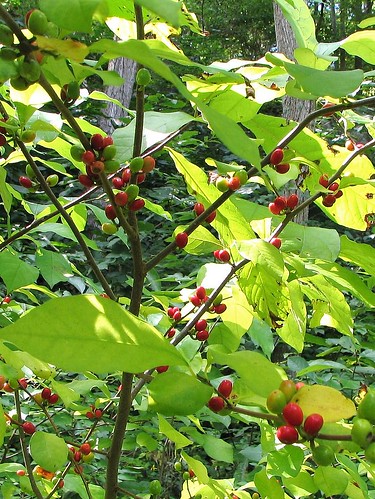 If you have ever been hiking in the woods in the DC area, chances are you've walked by hundreds of spicebush shrubs. They've got small yellow flowers in the spring, then they form a nondescript green backdrop in the woods for the rest of the summer. Until September -- when their berries turn bright red.
If you have ever been hiking in the woods in the DC area, chances are you've walked by hundreds of spicebush shrubs. They've got small yellow flowers in the spring, then they form a nondescript green backdrop in the woods for the rest of the summer. Until September -- when their berries turn bright red.Spicebush can grow up to 20 feet tall, but we commonly see them at about 5-10 feet. The leaves have smooth edges and alternate along the branch. As fall progresses, the leaves will turn yellow. The berries may remain on the shrub after the leaves have fallen off, but the birds may get to them first.
The twigs, leaves, and berries of spicebush all have a smell reminiscent of nutmeg or allspice when crushed. Presumably, the Latin name Lindera benzoin was given as a reference to benzoin resin, which was used to make incense and perfume in Asia and Europe. It's actually more related to laurels, including the bay laurel that gives us bay leaves.
 Spicebush parts don't just smell good -- you can use them as a spice. The twigs can be brewed in hot water to make tea. Berries can be used fresh or frozen, as an allspice substitute. (Steve Brill recommends against drying.) We'll often cook them up with sliced apples to make a delicious topping for pancakes. Each berry has a single seed inside, which can be ground up with the rest if you're going to use it as a spice -- that's a lot less work than trying to get the seed out of each one.
Spicebush parts don't just smell good -- you can use them as a spice. The twigs can be brewed in hot water to make tea. Berries can be used fresh or frozen, as an allspice substitute. (Steve Brill recommends against drying.) We'll often cook them up with sliced apples to make a delicious topping for pancakes. Each berry has a single seed inside, which can be ground up with the rest if you're going to use it as a spice -- that's a lot less work than trying to get the seed out of each one.  As you're looking for the berries, also take a peek if you see any leaves folded over. You might find the caterpillar of a spicebush swallowtail butterfly, whose only host plant is the spicebush. They're lovely black butterflies, but their caterpillars are adorable -- they have big eyespots that make them look like a cartoon snake. You might also find the caterpillar of a promethea silkmoth, a large and beautiful moth that we have seen far more as a cocoon hanging from spicebush than in any other stage of its life cycle.
As you're looking for the berries, also take a peek if you see any leaves folded over. You might find the caterpillar of a spicebush swallowtail butterfly, whose only host plant is the spicebush. They're lovely black butterflies, but their caterpillars are adorable -- they have big eyespots that make them look like a cartoon snake. You might also find the caterpillar of a promethea silkmoth, a large and beautiful moth that we have seen far more as a cocoon hanging from spicebush than in any other stage of its life cycle.In the wild: Spicebush is one of the dominant understory shrubs in our local forest. In Rock Creek Park, we recently noticed large groves on both sides of the Valley Trail, in the section east of Boundary Bridge.
In your yard: Spicebush need shade, but a few hours of sun will encourage them to flower more and set more fruit. They can also suffer if they get too dry, especially as they're getting established -- they'll do best with reasonably moist soil.
Like the photos in this post? Mouse over for credits; a click takes you to the photographer on Flickr.


